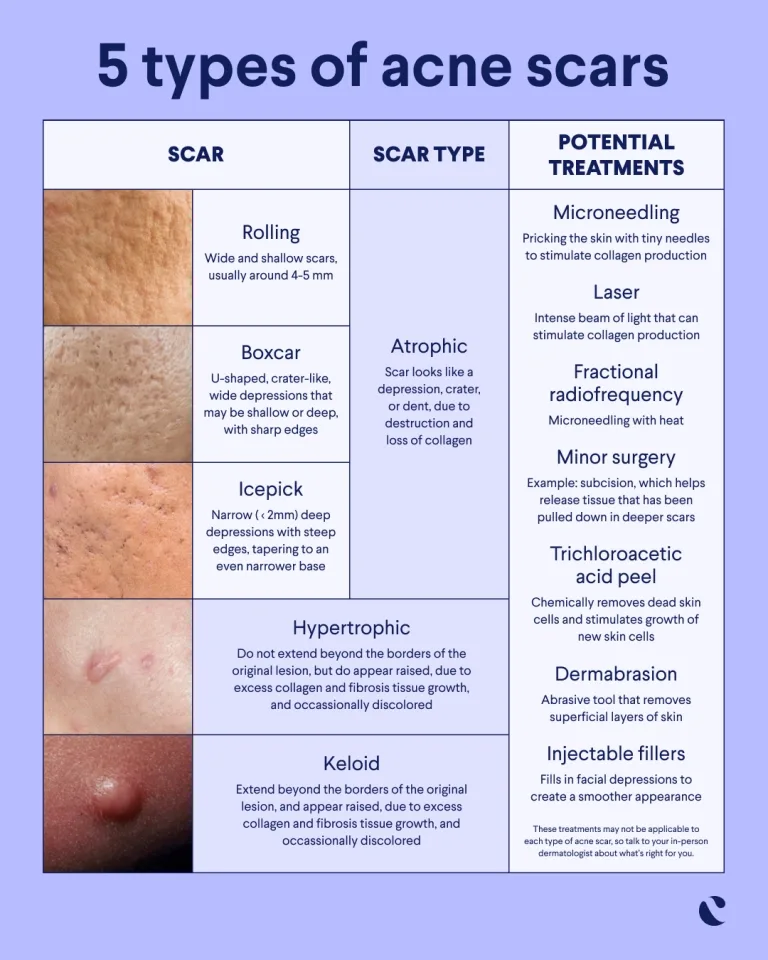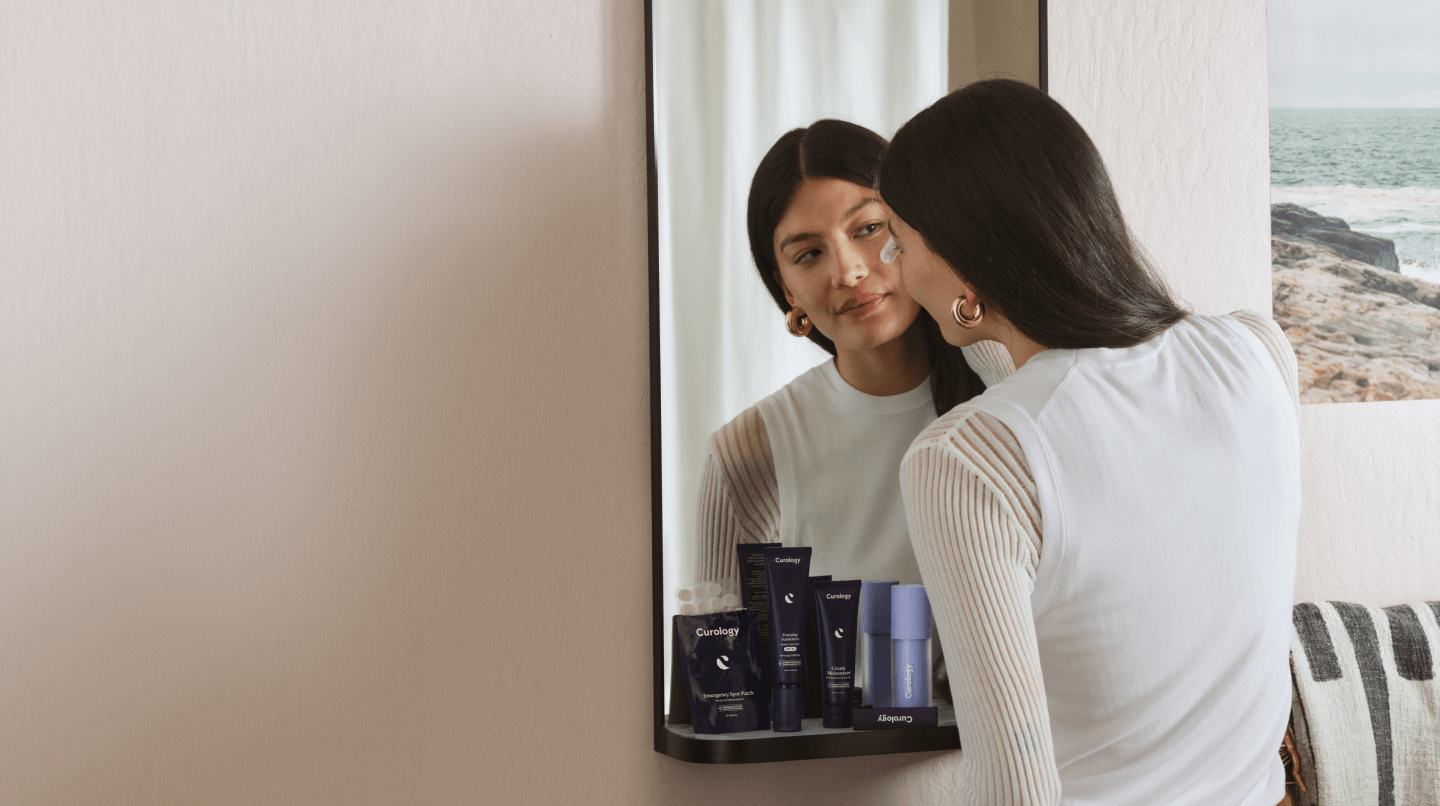How it works:
Share your skin goals and snap selfies
Your dermatology provider prescribes your formula
Apply nightly for happy, healthy skin
How it works:
How it works:
Share your skin goals and snap selfies
Your dermatology provider prescribes your formula
Apply nightly for happy, healthy skin
How it works:
How to help fade pimple marks, according to skin experts
After a breakout, acne scars are the last thing you want. Here’s what you can do to help minimize scarring.



Breakouts are common, and thankfully, they’re only temporary. But they can leave their mark—literally. Acne scars and dark spots from pimples can last for months to years. True acne scars can be permanent. The good news is there are things you can do to reduce their appearance and even your skin tone and texture.
Here we’ll explain why acne can leave marks on your face and how to tell the difference between acne scars and hyperpigmentation. We’ll also share tips on how to help fade pimple marks and prevent them from appearing in the first place.
What are acne scars?
Acne happens when dead skin cells mix with sebum and clog pores. Bacteria feed on the oil, leading to inflammation. And—pop!—a pimple is born.¹ As soon as certain types of acne form, the healing process begins—and it’s during this process that scarring can occur.
In simple terms, scarring occurs when the body’s collagen levels are off. Collagen is produced as part of the skin’s healing process. When the body produces too little collagen, it can result in a depressed (atrophic) scar. When it has too much, a raised (hypertrophic) scar can develop.
The bad news? Pimple scars don't go away naturally—at least, not completely. The good news? They may fade over time, and there are ways to help improve their appearance.

Is it scarring or hyperpigmentation?
Acne scars and hyperpigmentation can result from the healing process, and both leave marks. But they’re quite different—acne scars form from too little or too much collagen, and hyperpigmentation occurs when the body produces excess melanin, causing dark marks.
Hyperpigmentation resulting from acne is called post-inflammatory hyperpigmentation or PIH. It’s a form of skin pigmentation (just like sunspots or melasma). PIH can worsen if exposed to UV rays, which is why it’s all the more important to wear sunscreen. It doesn’t affect the skin’s texture, and PIH can be easier to treat than acne scars by using certain topical ingredients like hydroquinone and vitamin C.
It’s important to know that having skin marks following a breakout doesn’t mean that scars or dark spots will form. Remember, it can take a while for your skin to fully heal after a breakout—so don’t pop or pick at your pimples!
What are the types of acne scars?
We’re not going to lie. Some skin types—and types of acne—are simply more prone to scarring. Inflammatory acne that causes deeper skin lesions can damage the underlying tissue, leading to abnormal collagen formation when pimples clear. Acne scars may become less noticeable over time, but how long it takes for acne scars to fade can vary depending on the specific type. Here’s the 411 on the basic differences between each:²
Icepick scars are narrow, deep scars with steep edges. They taper into a narrow base.
Boxcar scars are U-shaped or crater-like depressions that can be shallow or deep, with sharp edges.
Rolling scars are wide and shallow. They undulate along the skin’s surface.
Hypertrophic scars are raised above the skin’s surface but confined to the borders of the original lesion. Discoloration and fibrosis can occasionally occur.
Keloid scars are also raised scars above the skin’s surface. Like hypertrophic scars, they can be fibrous and discolored. The difference is that keloid scars extend beyond the boundaries of the original acne lesion.

How can I treat and help prevent acne scars?
One of the best ways to help prevent acne scars is to allow your skin to heal independently. In other words, don’t pick or pop your pimples! We know that’s often easier said than done, but picking and popping can increase the likelihood of scarring.³ There is a difference between how to remove dark spots caused by pimples and acne scars. Hyperpigmentation (dark spots) is typically easier to treat because the skin tissue is not damaged. In contrast, with scars, the underlying tissue is damaged. So, if you’re wondering how to remove acne scars naturally, it can be complicated. Acne scars are permanent and may require an in-office procedure for optimal results.
That said, there are ways to help fade or treat pimple marks and acne scars, including:
Sun protection: Exposure to the sun's UV rays can make PIH more noticeable and lead to other dark spots (like sunspots), a type of hyperpigmentation unrelated to acne. Using a broad-spectrum sunscreen with SPF 30 or higher daily is one of the most effective ways to help reduce the appearance of scars and dark spots and help prevent future sunspots.
Chemical exfoliants (AHAs and BHAs): Alpha-hydroxy acids (AHAs) like citric acid, glycolic acid, and lactic acid work to remove dead skin cells to reveal healthier skin, which can help reduce the appearance of hyperpigmentation and scarring. Beta-hydroxy acids (BHAs) like salicylic acid penetrate deeper into the skin layers to clear clogged pores and decrease inflammation, helping to treat and prevent new acne from forming in the first place.
Chemical peels: These in-office procedures work similarly to over-the-counter AHA and BHA exfoliants, but they use higher strengths (and sometimes other ingredients) to remove scars and hyperpigmentation. A licensed dermatology provider should only perform them.
Microneedling: Another in-office procedure that should only be done by a licensed professional, microneedling uses a wand-like device with tiny needles to puncture the top layer of skin to stimulate collagen production. Microneedling may reduce acne scarring, but it usually requires multiple sessions before you notice results.
Dermabrasion and microdermabrasion: Both these in-office treatments can help reduce the appearance of PIH, but they work slightly differently. Dermabrasion uses a rapidly spinning brush to “sand” the skin, while microdermabrasion uses a gentler instrument. Dermabrasion is a more aggressive treatment that completely removes the epidermis to induce new collagen production. Microdermabrasion only removes the outermost skin layer to accelerate the natural exfoliation process, so it usually requires more than one treatment and may not be effective for deeper scars.⁴
Laser resurfacing: Your dermatology provider may recommend this type of procedure for reducing the appearance of boxcars or rolling acne scars. Laser treatments use light therapy to penetrate the deeper skin layers and eliminate scarred and pigmented skin. Intense pulsed light therapy (IPL) works similarly but is less invasive, generally speaking.
Surgery: In the case of severe or keloid scarring, minor surgery can help. Punch excision is a technique where the doctor “punches” through individual acne scars and repairs the wound using stitches or a skin graft. Subcision is a technique where the doctor loosens the fibers below the scar by inserting a needle under the skin.⁵
It’s important to remember many of these treatment options require some downtime to recover. During that time, your skin may seem to look worse, but it’s actually healing from the procedure. You can help it along by using a hydrating moisturizer with hyaluronic acid and ceramides to attract and seal in moisture. Also, as always, be sure to follow your medical provider’s instructions.

Preventative skincare with Curology
Acne scars are usually permanent, but they may improve with time. While certain procedures can help speed up the process, your best plan of attack is dedicating yourself to a proper skincare routine to help minimize breakouts in the first place. After all, fewer breakouts mean fewer opportunities for scars or hyperpigmentation to develop.
That’s where we come in! Curology helps take the guesswork out of your skincare routine—licensed dermatology providers work with you to examine your skin, assess your skincare goals, and provide custom treatment options. In fact, 95% of Curology members see clearer skin within 90 days.*
Get your personalized skincare routine with Curology
Get your personalized skincare routine with Curology


Becoming a member is easy. Just answer a few questions and snap a few selfies to help us get to know your skin. If Curology is right for you, we’ll prescribe a personalized prescription formula alongside recommendations for other products to try, like the acne body wash or emergency spot patch. We can also prescribe oral antibiotics for more severe or stubborn acne. And we’re always here to answer your questions because we believe expert guidance is the most important part of your skincare journey.
Your first month’s on us.** Just pay $5.45 (plus tax) to cover shipping and handling. Your prescription formula and other products you need will be shipped right to your door.
FAQs
Scarring occurs when the body’s collagen levels are off. Collagen is produced as part of the skin’s healing process. When the body produces too little collagen, it can result in a depressed (atrophic) scar. When it produces too much, a raised (hypertrophic) scar can develop.
Acne scars and hyperpigmentation can result from the healing process, and both leave marks. But they’re quite different—acne scars form from too little or too much collagen, and hyperpigmentation occurs when the body produces excess melanin, causing dark marks.
Icepick scars are narrow, deep scars with steep edges: They taper into a narrow base.
Boxcar scars are U-shaped or crater-like depressions that can be shallow or deep, with sharp edges.
Rolling scars are wide and shallow: They undulate along the skin’s surface.
Hypertrophic scars are raised above the skin’s surface but confined to the borders of the original lesion. Discoloration and fibrosis can occasionally occur.
Keloid scars are also raised scars above the skin’s surface. Like hypertrophic scars, they can be fibrous and discolored.
One of the best way to help prevent acne scars is to allow your skin to heal on its own. In other words, don’t pick or pop your pimples! We know that’s often easier said than done, but picking and popping can increase the likelihood of scarring.
P.S. We did the homework so you don’t have to:
Fabbrocini, G., et al. Acne scars: Pathogenesis, classification, and treatment.Dermatology Research and Practice. (2010, October 14).
Fabbrocini, G., et al. Acne scars: Pathogenesis, classification, and treatment.Dermatology Research and Practice. Ibid.
American Academy of Dermatology. Pimple popping: Why only a dermatologist should do it. (n.d.).
Fabbrocini, G., et al. Acne scars: Pathogenesis, classification, and treatment.Dermatology Research and Practice. Ibid.
Fabbrocini, G., et al. Acne scars: Pathogenesis, classification, and treatment.Dermatology Research and Practice. Ibid.
Meredith Hartle is a board-certified Family Medicine physician at Curology. She earned her medical degree at Kirksville College of Osteopathic Medicine in Kirksville, MO.
*In a clinical trial of 150 Curology patients. 95% saw improvement after 12 weeks. Self-reported.
**Subject to consultation. Subscription is required. Trial is 30 days. Results may vary.

Curology Team

Meredith Hartle, DO
Related Articles
Choosing the right sunscreen: Why non-comedogenic options are a game-changer for clear skinIs your makeup pilling? Here’s how to help prevent it from happeningThe 5 best chemical exfoliators for glowing skinCurology products and your routine: The ultimate guideWhich tretinoin is right for you, according to Vogue?Popular Articles
Ask Curology: Is my cold breaking me out?Slugging: The dermatologist-approved skincare hack going viral on TikTokTretinoin vs retinol: What’s the difference?How to create a self-care routine that actually sticksYour 2023 skincare horoscopeTry prescription skincare
Get routine essentials


Face what’s next with Future-ProofRx
Face what’s next with Future-ProofRx
- Skin texture
- Fine lines
- Wrinkles
- Dark spots
- Dullness
$29.95/month